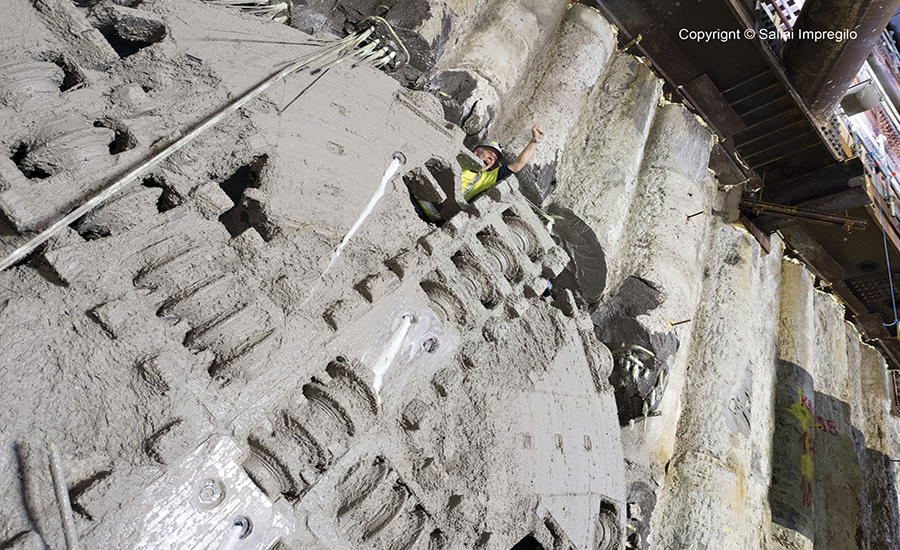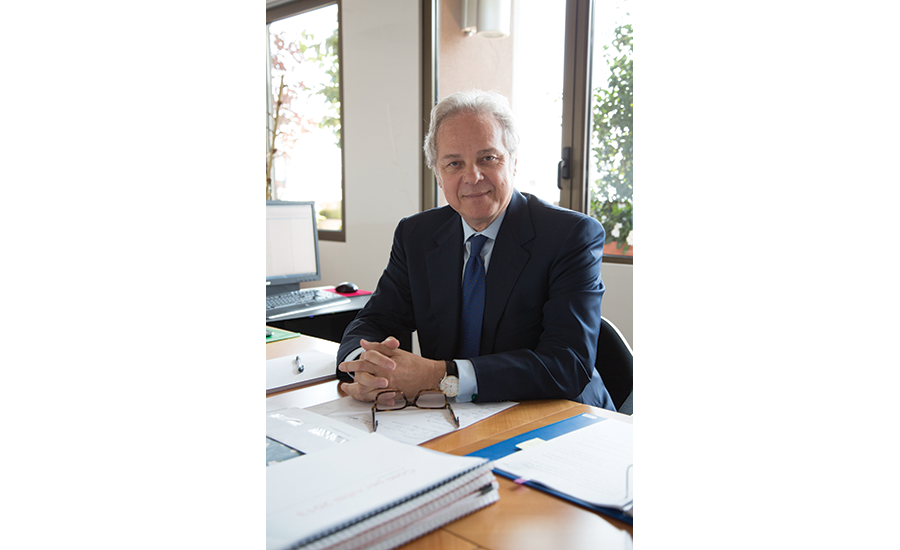Risk Management
Salini Impregilo Expects U.S. Acquisition To Cut Risk, Raise Profit Margins
Pietro Salini shifts the focus to North America

The Italian contractor built its reputation for technical expertise on complex, far-flung megaprojects, such as Copenhagen’s metro system
PHOTO COURTESY SALINI IMPREGILO

The Italian contractor built its reputation for technical expertise on complex, far-flung megaprojects, such as the Angostura hydropower project in Chile.
PHOTO COURTESY SALINI IMPREGILO

Pietro Salini
PHOTO COURTESY SALINI IMPREGILO

Salini Impregilo expects Lane Construction to build on its U.S. road and rail work, such as Charlotte’s LYNX light-rail extension
PHOTO COURTESY LANE CONSTRUCTION

Lane CEO Robert Alger joined Salini Impregilo CEO Pietro Salini in London in May to roll out the parent’s four-year strategic plan.
PHOTO COURTESY OF SALINI IMPREGILO

Salini Impregilo has won its share of Australian jobs, as the country builds out its transportation network. The firm is working on Sydney’s North West Rail Link and Perth’s light-rail expansion. Melbourne system work is pending.
PHOTO COURTESY SALINI IMPREGILO

This summer, the contractor began boring the Brenner Base Tunnel through the Italian Alps. The 55-km portal is a key link in Europe’s highspeed- rail network, which will stretch from Berlin to Palermo.
PHOTO COURTESY SALINI IMPREGILO

The Copenhagen Cityringen Metro project, one of the world’s most modern metro systems, will add two single-track rings under the city, with 17 new stations, including one near the landmark Frederik’s Church.
PHOTO COURTESY SALINI IMPREGILO








One afternoon this May, a group of journalists and market analysts convened in London at the Royal Society headquarters in Carleton House to hear the CEO of Salini Impregilo unveil the Italian engineering and construction conglomerate’s strategy for the next four years.
Acknowledging the society’s historic past, Pietro Salini began with a droll aside, saying, “It’s a little intimidating to be here in the same room with Sir Isaac Newton and Benjamin Franklin.”
Actually, the Royal Society was housed elsewhere when Newton was its president and when Franklin unveiled his lightning rod. But with his understated Roman charm and sophistication, the 58-year-old construction executive made a larger point: Salini Impregilo is betting on North America, following last year’s acquisition of Lane Construction, a Cheshire, Conn.-based road contractor active in 20 states. The parent company’s U.S. involvement dates from 1982, when Impregilo bought the S.A. Healy Co., a Henderson, Nev.-based heavy-civil contractor known for tunneling expertise.
Current projects featuring Healy crews in a key role include the Dugway Storage Tunnel in Cleveland and the Anacostia River Tunnel in Washington, D.C. In recent years, Healy crews also worked on the San Francisco Metropolitan Transit Authority’s Central Subway Project and the Lake Mead third intake tunnel, near Las Vegas.
Following a 2011-12 reverse-takeover battle in which Salini, Italy’s third-largest construction firm, took over Impregilo, the largest, Salini Impregilo has steadily climbed ENR’s Top International Contractor rankings. In the 2012 list, which are based on 2011 pre-takeover revenue, Salini, ranked at No. 71 behind No. 49 Impregilo.
The combined firm, which claims about 35,000 employees and projects in some 50 countries, occupied the 27th spot the following year and is No. 25 this year. (Because the Lane deal wasn’t finalized until the first quarter of this year, Lane’s revenue does not count in the current listing. Had those numbers been included, Salini would have ranked at No. 22.) If events unfold as Pietro Salini expects, the parent company will move up a few notches on next year’s list.
And that is just the beginning, Salini says. Salini Impregilo will continue to chase complex highway and hydropower projects around the world. The company, as part of the Isarco consortium, this summer began work on a 5.8-kilometer section of the 55-km Brenner Base Tunnel in the Italian Alps. A key component of the Trans-European Transport Network, it will link Italy and Austria, eventually providing high-speed-rail availability from Munich to Verona.
Major new contracts Salini Impregilo inked this year include railway work in Australia and major hydropower jobs in Tajikistan and Ethiopia. Twin-bore tunnels more than 8 km long will link Perth’s airport to the city’s suburban rail network.
On the Vakhsh River in southern Tajikistan, the Rogun Dam—with construction costs estimated at $3.9 billion and designed to produce 3,600 MW of electricity—is complex and controversial. The dam’s rockfill and clay core will rise 335 meters, which will make it the tallest in the world, the contractor says. Neighboring Uzbekistan opposes the project, fearing damage to the environment and that country’s economy, which depends heavily on cotton. However, a World Bank-financed study concluded that environmental impacts would be minimal and easily addressed.
In Ethiopia, the €2.5-billion Koysha dam will have an installed capacity of 2,200 MW. Following the Gibe III and Grand Ethiopian Renaissance dam hydro projects, which are recently finished or nearing completion, Koysha is aimed at making Ethiopia the dominant player in power production in East Africa. The country already has signed supply agreements with Kenya and Sudan, but the environmental group International Rivers and others question the wisdom of such large and costly infrastructure in one of the world’s poorest countries.
Salini Impregilo’s reputation for executing complex megaprojects in remote corners of the world is well deserved, but sometimes geopolitics can throw a wrench into the works. For years, the firm worked in Libya, but it suspended work on more than $3 billion worth of projects and pulled out staff members after the Arab Spring toppled the Gaddafi regime. Salini is eager to resume work as soon as the situation stabilizes, but it remains to be seen whether the new government will honor contracts signed by its predecessor.
Similarly, the contractor admits that it has had difficulty collecting payments for work on a number of projects in Venezuela, where declining oil prices have revealed the underlying weakness in President Nicolas Maduro’s socialist economic policies. As the country’s standard of living has spiraled downward, crime and inflation have soared, and Maduro simply stopped paying the bills. In 2014, Venezuelan work accounted for 6% of Salini Impregilo’s backlog. The company is unlikely to recoup the debt any time soon.
It is not surprising that Salini Impregilo is looking to grow its business in a safer environment. “We want to reduce our risk profile by targeting the U.S. Acquiring Lane will help us to generate a large cash flow, which will enable us to reduce our debt and, in the near term, to release more cash to shareholders,” Salini says. By the end of 2019, the company expects to move annual revenue to €9 billion ($10.2 billion) from approximately €6 billion ($6.8 billion) at present, he added.
Simply put, the plan is to bump up Lane from a 20-state roadbuilder into a nationwide heavy-civil player. Operations will continue to be run from Lane’s headquarters in Connecticut. For now, Lane and Healy will retain their brand names, but Healy will operate as a unit of Lane.
“Our marching orders are to grow our business from $1.75 billion now to $3 billion in four years,” says Lane CEO Robert Alger. That would account for about 30% of Salini Impregilo revenue, based on forecasts.
For Salini, lowering his company’s risk profile is the next challenge in his quest for growth. About five years ago, as CEO of Salini Construttori SpA, a privately held firm founded by his grandfather in 1936, he perceived that publicly traded Impregilo, the largest construction firm in Italy, had become stagnant and inefficient.
Salini Construttori was a smaller company, ranked third and doing $1.4 billion a year in revenue compared to $2 billion for Impregilo. However, Salini saw an opportunity and moved to acquire more than 25% of the shares.
Impregilo’s own founding dates from a 1950s joint venture of three Italian companies—Girola, Impresit and Lodigiani—to build Kariba Dam, a 430-ft-tall concrete arch impoundment on Zimbabwe’s Zambezi River (ENR 6/17/82 p.74). A fourth partner in the dam construction, Torno, dropped out before the merger took effect.
The successful JV became permanent in 1960. Over the next few decades, Milan-based Impregilo built a reputation for engineering and construction excellence around the world, completing massive hydropower projects at remote sites with challenging conditions. Signature projects during this period included the Tarbela Dam in Pakistan, the Mosul Dam in Iraq, the Lar Dam in Iran, a pair of James Bay dams in Quebec, Salto Grande and Alicopa in Argentina, and Yacyreta Dam between Argentina and Paraguay, as well as other hydro megaprojects in China, Ethiopia, Ghana, Malaysia, Colombia, Venezuela, Ecuador, Panama, Iceland and elsewhere.
Success in dambuilding opened other heavy-civil opportunities around the globe. No job was too tough for the scrappy Italian multinational contractor.
The Impregilo logo turned up on high-profile jobsites in other sectors: metro work in Sydney, San Francisco, New York City, Milan, Rome, Paris and Copenhagen, as well as railway-system work in Portugal, Iran and the Alps. The company’s road and bridge work included large projects in Italy, Sudan, Brazil, Argentina, Chile, Morocco, Sudan, Singapore and the U.S.
But despite a high turnover rate and a healthy backlog that included work on blue-ribbon assignments such as the Panama Canal’s third-lane expansion, it seemed to Salini that the company had lost its edge.
Salini, a business and economics graduate of Rome’s prestigious La Sapienza University, felt that once Impregilo came under the control of three powerful business families—the Benetton, Ligresti and Gavio clans—the Milan-based company had drifted from pure construction into highway concessions and other diversions from its core competencies. Consequently, the company’s emblematic focus on creative, competitive engineering and construction had morphed into a conservative accounting practice, an ATM that spit out cash to company insiders but offered little tangible benefit to shareholders. Impregilo was still stocked with a wealth of E&C talent, but it was not being put to good use, he thought. “Contractors must be productive,” he says. “It is our nature. A contractor is never hesitant to take action, to make a decision.”
The telltale indicator that this was no longer true at Impregilo was when Turkey asked for proposals for work on the third bridge over the Bosphorus in Istanbul. The $3-billion road-and-rail crossing—designed by Michel Virlogeux, the ENR 1995 Award of Excellence winner—is scheduled to open by the end of the month. Salini was astonished to discover that Impregilo, which had worked on the second bridge, did not submit a proposal, even as a joint-venture subcontractor.
In any case, Salini observed, Impregilo was not performing up to its potential, and the stock market agreed. “The share price was cheap,” he says. He pounced, snapping up shares of the biggest construction outfit in Italy and triggering a contentious battle for control. Typically, in Italy, controlling shares in many big, publicly held companies are held by families and disputes are handled discretely, in private. But Salini took the fight public, offering shareholders a tidy profit and arguing that he would create value by returning Impregilo to its construction and engineering roots.
Ultimately, Salini prevailed, winning shareholder approval to replace Impregilo’s Gavio-backed board of directors with a slate of his own in mid-2012; he ended up with more than 62% of the shares. A year later, the acquisition of Salini Impregilo was finalized.
The takeover fight boosted share value by 30% in 2012. Long-term shareholders finally were reaping tangible rewards. Revenue for the newly integrated firm was pushing €4 billion ($4.5 billion) per year.
Salini quickly moved to reassure nervous employees at Impregilo’s headquarters in Milan, spending two to three days a week there and the remainder of his working time at the Rome office. Following the Lane purchase, U.S. employees also were told that changes in corporate culture would be minimal and that the game plan was to grow, not shrink. “We’re in alignment,” says Alger. “Our debt has been wiped out. We have the bonding capacity now to chase big jobs, $250 million-plus, that we didn’t have before. We’ve identified nine big projects that we feel we have a good shot at. It’s a matter of execution. Right now, we’re on target with revenue and a little ahead of pace on margins through July.”
The market isn’t buying into Pietro Salini’s grand vision yet. Shares were trading at about €3.7 on the Borsa Italiana in May, when he rolled out the four-year plan. Following the Brexit vote, the price has slipped to about €2.65. But Salini himself is encouraged by half-year results through June and is looking long term.
“We have the pieces in place now and the competence to succeed. Now, we have to execute,” he says. “And we will.”










